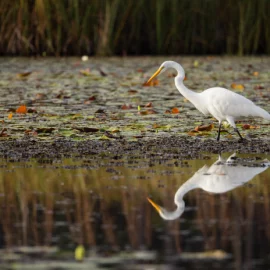
A rare and elusive bird recently found to thrive in a narrow strip of the Louisiana coast isn’t getting the protections that should come with its new status under the Endangered Species Act, according to a lawsuit that environmental groups plan to file against the federal government. n a formal notice of intent to sue, the Center for Biological Diversity and Healthy Gulf on Wednesday challenged a decision made in the final months of President Donald Trump’s administration to block habitat protections for the eastern black rail, a small, red-eyed bird that scientists are only now beginning to understand.
nola.com
The Trump administration did give the eastern black rail a “threatened” status but did not protect the environment they live in.
The Trump administration granted the black rail “threatened” status in October after a decade of petitions and lawsuits from environmental groups. But the administration did not designate the bird’s “critical habitat,” areas occupied by the species and deemed essential for its conservation. The designation does not set up a preserve or refuge, nor does it prohibit most development, but it can affect federal agency actions, including funding, permits and projects. In an explanation that confounded many bird experts, federal wildlife officials said habitat protections might actually harm the bird by disclosing its few places of refuge to overzealous bird watchers, potentially frightening the birds and trampling nests that the birds hide in grasses on the ground. Center for Biological Diversity attorney Kristine Akland called the justification “absurd.” “If the eastern black rail is going to have any chance at recovery, coastal wetlands must be protected from polluting industries, developers and sea-level rise,” she said. “The Trump administration’s ridiculous refusal to identify critical habitat imperils these beautiful birds and should be tossed into the dustbin of history, along with the rest of his wildlife-killing policies.”
The bird lives and nests on the ground in remote wetlands and seldom flies. This is the habitat that is fast receding by both rising waters and development. There is a greater emphasis in studying the bird now as it is hoped that the Biden administration will grant habitat protections.
Since 2017, Audubon Louisiana has collected one of the North America’s richest pools of data on the bird. The research, focused in Cameron and Vermilion parishes, has more than quadrupled the number of confirmed black rail sightings in Louisiana. It’s also producing new insights into how the black rail feeds, migrates and breeds, all of which could guide new endangered species protections. The U.S. Fish and Wildlife Service predicts the bird will likely be extinct within 50 years if wetlands continue to be lost in coastal areas.



